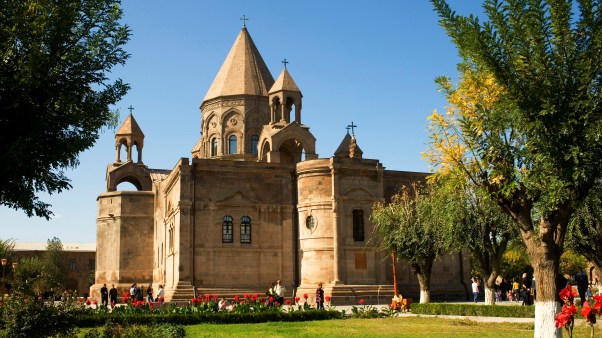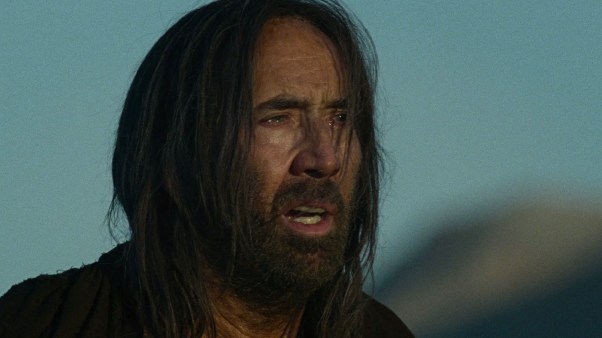 Bishop Scott Jones isn’t the first United Methodist bishop to join the Global Methodist Church since the theologically conservative denomination launched in May, but his exit from the UMC has arguably caused the greatest stir.
Bishop Scott Jones isn’t the first United Methodist bishop to join the Global Methodist Church since the theologically conservative denomination launched in May, but his exit from the UMC has arguably caused the greatest stir.That’s partly because of the unique position his family holds in Methodism and the “extreme center” position he had staked out within the United Methodist Church.
For some, it also casts a different light on his retirement, just days before he joined the GMC, as head of the Texas Annual Conference where about half of its churches—more than any other conference in the United Methodist Church—likewise left the denomination.
“The Jones family is truly one of the first families of Methodism in our church,” said Will Willimon, a retired United Methodist bishop and a professor of the practice of Christian ministry at Duke Divinity School in Durham, North Carolina.
Willimon added, “This family has been a family of leaders of our church, and it’s such a shock to have one of the members of the family leading churches out of our church.”
Jones’ late father, S. Jameson Jones, Jr., was president of the Iliff School of Theology in Denver and then dean of Duke Divinity School—two United Methodist schools.
His brother, L. Gregory Jones, now the president of Belmont University, previously served as dean of Duke Divinity School, arguably Methodism’s premier seminary.
And one of his three children, Arthur Jones, is senior pastor of a United Methodist Church: St. Andrew United Methodist Church in Plano, Texas, which is currently negotiating to leave the UMC.
Both Arthur Jones and Greg Jones declined to be interviewed for this article.
“So when you talk about family involvement, there is a lot of that,” Bishop Jones said, who after seminary got his Ph.D. in religious studies from Southern Methodist University in Dallas.
He wrote his dissertation on the history of biblical interpretation and John Wesley, one of the founders of Methodism, because, he said, “I recognized that how Christians interpret the Bible is the most controversial question in Christianity today.”
That question is at the heart of a controversy that has haunted the United Methodist Church for decades and has led to the current split: whether to ordain and marry LGBT Christians.
In 2020, delegates to the global UMC’s General Conference were expected to consider a proposal to split the denomination, but the meeting was subsequently delayed three times due to the pandemic. After the third pushback to 2024, the Global Methodist Church, which is against ordaining LGBT clergy and marrying same-sex couples, split from the United Methodist Church earlier this year.
Jones—who pastored several congregations in Texas and taught at the Perkins School of Theology at Southern Methodist University before he was elected bishop in 2004—had previously positioned himself in what he calls the “extreme center,” a phrase he said he first encountered in The Economist.
He wanted to convey how Methodist doctrine holds in tension things other Christians may see as contradictory, such as evangelism and social action.
After reaching out to the magazine to make sure it wasn’t trademarked, Jones said, he wrote it into the title of his 2002 book United Methodist Doctrine: The Extreme Center, his social media presence and his website.
Methodist doctrine is “conservative in some ways and liberal in other ways; it occupies the extreme center and is totally opposed to the dead center,” he explained in his 2008 book, Staying at the Table: The Gift of Unity for United Methodists, in which he argued the debate over homosexuality was “a symptom of deeper disagreements,” including Christology, ecclesiology and authority of Scripture.
Alongside essays from a diverse group of United Methodist leaders, he wrote that he believed the denomination should not split.
“Now, years later, I realized that my hope and my dream turned out not to be possible because the church has in fact, split this last year,” Jones told Religion News Service. “But it was a desire to try to do whatever I could to hold it together and point the way forward. It just didn’t work.”
It didn’t work, he said, because some church leaders and regional conferences have taken action to oppose the denomination’s official stance barring LGBT members from ordination and marriage.
“These doctrinal and moral disobedience questions have made it hard to keep the idea that we really are a church following the same Book of Discipline,” he said.
In June, after more than 18 years as a bishop, he announced he was retiring from the United Methodist Church. But, Jones said, he thought he might have a few more years of “good service to Christ” and wanted to go where he was most needed.
In the meantime, he said, he continued helping churches in the Texas Annual Conference discern whether to remain United Methodist or join the Global Methodist Church, recording videos, writing articles and leading decision-making processes. Either was a great option, he said.
“I think God has a great future for the United Methodist Church. God also has a great future for the Global Methodist Church, and people needed to decide which place could they best serve Christ,” he said.
On vacation for the last few weeks of December, he said it was time for his own discernment.
On the last day of 2022, nine days after his retirement, he joined The Global Methodist Church as an elder and bishop in the fledgling denomination.
The move touched a nerve with Methodists.
The Rev. Keith Boyette, who heads the Global Methodist Church as its transitional connectional officer, said in a statement at the time that the GMC was “rejoicing over God’s good grace to us,” calling Jones a “tremendous blessing” to the new denomination.
Boyette told RNS he commends Jones for creating a “fair playing field” for churches and clergy to discern whether to stay in or leave the United Methodist Church, though he understands others might be critical.
The Rev. David Donnan—pastor of Glennville Methodist Church, a Global Methodist congregation in Glennville, Georgia—penned a blog post titled, “Why Scott Jones is a Bigger Deal than You Think.”
“By moving he is demonstrating how his views align better in the Global Methodist Church. This (is) more than any person moving. This is the extreme center poster child himself moving out,” Donnan wrote.
Others were skeptical of the timing.
In his own post, which came in the form of a satirical video on his Picklin’ Parson YouTube page titled “Dear Bishop: What Took You So Long?,” the Rev. Stan Copeland of Lovers Lane United Methodist Church in Dallas said he wasn’t surprised.
Copeland had already raised the alarm about Jones and two other bishops he said had provided “promotion and support” to the Global Methodist Church, all the while being paid by the UMC.
The Texas Annual Conference, once one of the strongest conferences in the UMC, has lost 302 of its nearly 600 churches since 2019, according to United Methodist Church data. That doesn’t happen if a bishop is presenting neutral information, Copeland said.
Jones then retired—with benefits, Copeland stressed—before joining the new denomination himself.
“I think when he wrote those books, he really believed in an extreme center, but he’s extreme right of center now,” he said.
Boyette said Jones had been part of the 2020 gathering that produced a statement outlining a vision for what became the Global Methodist Church, but they had not discussed any potential role for the bishop within the denomination until after Jones retired.
The bishop was “very insistent on observing those appropriate boundaries,” said Boyette.
Jones maintains he provided a process that allowed clergy and local churches to make “a genuine discernment.”
“And I provided high quality, accurate information that helped people see what was going on,” he said. “For example, I said the United Methodist Church is going to be moving in a progressive direction over the next several years. The only question is how far will it go and how fast? I was criticized for telling people that, but I believe it’s the truth.”
Jones and Bishop Mark Webb, who left the United Methodist Church just before him, are tasked with overseeing all the congregations in the Global Methodist Church — about 1,100, as of mid-January.
A third retired United Methodist bishop, Bishop Emeritus Mike Lowry, had joined the new denomination’s Transitional Leadership Council ahead of its launch.
The Global Methodist Church’s nine provisional annual conferences and districts are now holding convening gatherings. By the time its three Texas conferences — Mid-Texas, Great Plains and Eastern Texas—finished meeting earlier this month, Jones said they had ordained about 120 new clergy and received a number of United Methodist clergy, who can transfer their credentials to the new denomination.
It’s difficult to build something from scratch, the bishop said, but he believes the Global Methodist Church has a lot of potential.
“It’s exciting to be in a community of people who are focused on worshipping passionately, loving extravagantly and witnessing boldly. I love that mission statement and look forward to being a part of it,” he said.
At the same time, he wishes the best for the denomination that was his home for so long.
“They can reach people that the Global Methodist Church will never reach, and that’s a good thing.”
I’ve got to admit: Google’s Galileo logo on Tuesday was pretty cool. The site explained that it celebrating the “400th Anniversary of Galileo’s First Telescope.”
Well, that’s accurate in its generality if not in the specifics. On August 25, 1609, Galileo first demonstrated his “spyglass” to officials in Venice. He apparently created it sometime earlier.
Yes, that’s an annoying nitpick that completely misses the point of the celebration. Let’s call Google close enough. But far less accurate are many of the other big “facts” that went through people’s minds when they heard of the anniversary this week.
1. Galileo invented the telescope.
No. Others had figured out that if you put two lenses together you could see distant objects. Dutch lensmaker Hans Lipperhey applied for a patent in 1608. Galileo’s was better. But it wasn’t his first. As he later wrote:
About ten months ago a report reached my ears that a certain Fleming had constructed a spyglass by means of which visible objects, though very distant from the eye of the observer, were distinctly seen as if nearby. [The report] caused me to apply myself wholeheartedly to inquire into the means by which I might arrive at the invention of a similar instrument. This I did shortly afterwards, my basis being the theory of refraction. First I prepared a tube of lead, at the ends of which I fitted two glass lenses, both plane on one side while on the other side was one spherically convex and the other concave. Then placing my eye near the concave lens I perceived objects satisfactorily large and near, for they appeared three times closer and nine times larger than when seen with the naked eye alone. Next I constructed another one, more accurate, which represented objects as enlarged more than sixty times. Finally, sparing neither labor nor expense, I succeeded in constructing for myself so excellent an instrument that objects seen by means of it appeared nearly one thousand times larger and over thirty times closer than when regarded with our natural vision.
Well, eventually, anyway. National Geographic describes the version that Galileo took to the Venetian leaders like this: “Made of wood and leather, Galileo’s telescope had eight-times magnification, a convex main lens, and a concave eyepiece that—unlike other telescopes of the period—presented the image the right way up.”
By the way, the word telescope wasn’t used until 1611.
2. So he didn’t invent it, but he was the first to use it to look into space.
Actually, he told the Venetian officials that it was for terrestrial purposes. Oxford science historian Alan Chapman told National Geographic, “Galileo [took] a number of senators up to one of the bell towers in Venice where you can see ships out in the lagoon.” At the time, Venetian vessels were being attacked by the Turks. As Saswato R. Das wrote in The New York Times this week, the telescope let watchmen “see ships sailing into Venice’s harbor a full two hours before they became visible to the naked eye.”
Thomas Harriot meanwhile, was using a telescope to make sketches of the moon’s surface. If you wanted to celebrate that 400th anniversary, too late: it was July 26.
3. Well, “firsters” often aren’t first. The important thing is that when he did look into space and published his findings that the earth really wasn’t the center of the universe, it caused outrage throughout Christendom.
“It’s tempting to see it representing a fundamental break in the relations between science and religion, but I don’t think it represented anything of the sort,” says science historian Ron Numbers, editor of the recently published Galileo Goes to Jail and Other Myths About Science and Religion (Harvard University Press). “In fact, at the time, it aroused relatively little interest. It was only in later decades and centuries that it came to be seen as a representation of what supposedly happens to scientific pioneers when they dare to try to correct the church’s teachings.”
In Sightings, Karl E. Johnson recently summarized some of the other facts that get in the way of the science vs. faith narrative.
Galileo’s Dialogue Concerning the Two Chief World Systems, the source of controversy, previously had been read and approved by the Church’s censors; and Pope Urban VIII, who presided over the trial, was Galileo’s friend and admirer. Consider also: prior to the trial, Galileo stayed in the Tuscan embassy; during the trial, he was put up in a six-room apartment, complete with servant; following the trial, his “house arrest” consisted of being entertained at the palaces of the grand duke of Tuscany and the Archbishop of Siena. Galileo, apparently, was no ordinary heretic.
4. Friendly or not, the Roman Catholic Church thought Galileo’s science contradicted Scripture and therefore could not be true! That’s why Cardinal Bellarmine ordered Galileo to back away from Copernican theory.
Well, there is this quote:
In the learned books of worldly authors are contained some propositions about nature which are truly demonstrated, and others which are simply taught; in regard to the former, the task of wise theologians is to show that they are not contrary to Holy Scripture; as for the latter (which are taught but not demonstrated with necessity), if they contain anything contrary to the Holy Writ, then they must be considered indubitably false and must be demonstrated such by every possible means.
But that came from Galileo. Cardinal Bellarmine, a friend of Galileo, said this:
If there were a true demonstration that the sun is at the centre of the world and the earth in the third heaven, and that the sun does not circle the earth but the earth circles the sun, then one would have to proceed with great care in explaining the Scriptures that appear contrary, and say rather that we do not understand them than that what is demonstrated is false. But this is not a thing to be done in haste, and as for myself I shall not believe that there are such proofs until they are shown to me.
At issue were biblical texts that said the earth “cannot be moved.” But a geocentric view of the universe owed more to the Greek mathematician Ptolemy than to Scripture.
5. Bellarmine or no, the church declared Galileo a heretic and had him tortured.
Well, that Galileo believed in the authority of Scripture is not to say that he and the Church agreed. He was, after all, forced to recant his belief in heliocentrism. “Who can doubt that it will lead to the worst disorders when minds created free by God are compelled to submit slavishly to an outside will?” he wrote “When we are told to deny our senses and subject them to the whim of others?”
But Voltaire’s line that Galileo “groaned away his days in the dungeons of the Inquisition” (or Sam Harris’s line that the church had a habit of “torturing scholars to the point of madness for merely speculating about the nature of the stars”? Not true.
As Numbers says:
Galileo suffered very little abuse at the hands of the Catholic Church. He was never tortured, he never faced death. In fact, he was never imprisoned. His penalty was house arrest at a pleasant villa on the outskirts of Florence, Italy.
Galileo’s problems with the church stemmed far less from his astronomical and physical views than from his lack of diplomacy, and from his impertinence in trying to instruct the church on how to interpret Scriptures, as some Protestants had attempted to do in the previous century. Furthermore, in writing his controversial book, Galileo had the impertinence to attribute the Pope’s views to a simple-minded character named Simplicius. This Pope [Urban VIII] had once been a patron of Galileo’s and had supported his scientific efforts, so such a lack of diplomacy turned even the Pope against his one-time friend. … There was never any indication in the court records of death being a possible penalty, and no other scientists were put to death for their scientific views.
Voltaire and Harris aside, the widespread belief that Galileo was tortured probably doesn’t stem from malice toward religious belief. Rather, Maurice Finocchiaro argues in Galileo Goes to Jail, the Inquisition’s declaration that it would subject Galileo to “rigorous examination” was probably understood by many contemporaries to mean he would be tortured, since that was a common euphemism at the time (though it was rare in Rome’s Inquisition). Indeed, the record shows that there was an actual threat of torture. But all historical indications are that Galileo didn’t suffer it.
6. Still, the bottom line is that Galileo was right and the church was wrong.
One of Galileo’s main points in proving heliocentrism is that the earth’s revolving around the sun is responsible for the tides. Similarly, he said the planets orbited the sun in perfect circles. Johannes Kepler, meanwhile, was right on both issues, and did a better job of showing evidence for his claims. He also, by the way, came up with a better way of making telescopes two years after Galileo’s demonstration in Venice. But Galileo never adopted Kepler’s improvements.
(For more on Galileo, Kepler, and their contemporaries, see Christian History‘s issue 76: The Christian Face of the Scientific Revolution)
Image: Painting of Galileo Galilei, 1605, by Domenico Robusti via Wikimedia Commons.








